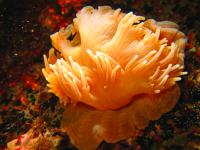
This may be a new species of sea anemone. There are unknown creatures lurking under the windswept islands of the Aleutians, according to a team of scientific divers from the University of Alaska Fairbanks.
This summer, while completing the second phase of a two-year broad scientific survey of the waters around the Aleutian Islands, scientists have discovered what may be three new marine organisms. This year's dives surveyed the western region of the Aleutians, from Attu to Amila Island, while last year's assessment covered the eastern region.
During the dives, two potentially new species of sea anemones have been discovered. Stephen Jewett, a professor of marine biology and the dive leader on the expedition, says that these are "walking" or "swimming" anemones because they move across the seafloor as they feed. While most sea anemones are anchored to the seabed, a "swimming" anemone can detach and drift with ocean currents. The size of these anemones ranges from the size of a softball to the size of a basketball.
Another new species is a kelp or brown algae that scientists have named the "Golden V Kelp" or Aureophycus aleuticus. According to Mandy Lindeberg, an algae expert with NOAA's National Marine Fisheries Service and a member of the expedition, the kelp may represent a new genus, or even family, of the seaweed. Up to ten feet long, the kelp was discovered near thermal vents in the region of the Islands of the Four Mountains.
"Since the underwater world of the Aleutian Islands has been studied so little, new species are being discovered, even today," said Jewett. He adds that even more new species may be revealed as samples collected during the dives continue to be analyzed.
The organisms were found while surveying more than 1000 miles of rarely-explored coastline, from Attu to the Tigalda Islands. Logging more than 300 hours underwater, the divers collected hundreds of water, biological and chemical samples during 440 dives. Armed with underwater cameras and video cameras, the divers took hundreds of photographs and dozens of short movies of the creatures that inhabit the coast of the Aleutians.
According to Jewett, the scientists are reasonably sure that the kelp is a new species, but more work is being done to confirm that the sea anemone species are completely new to science. Correspondence with anemone experts has so far shown the anemones to be new species, but the analysis is ongoing.
During both years, the chief scientist on the project was Douglas Dasher, a water quality expert from the Alaska Department of Environmental Conservation. The scientific team operated from the R/V NORSEMAN, a 108-foot vessel originally designed for crab fishing in the Bering Sea.
The dives were part of a broad health assessment of the Aleutian Islands and were sponsored by the Alaska Environmental Monitoring and Assessment Program, also referred to as AKMAP. The program is funded by the Environmental Protection Agency and managed through a joint agreement between the ADEC and UAF.
Samples from the dives are being used to catalog biodiversity in the region, assess water quality and potential contaminants. According to Jewett, this is the first time the remote nearshore region of the Aleutian Chain has undergone an in-depth marine assessment.
The rugged and remote islands of the Aleutians are not immune to the reach of human activity, say scientists leading the expedition.
"Pollutants traveling through air and water pathways from temperate latitudes have been showing up in the area," says Jewett. "Debris and spills from World War II in the Aleutians have left their mark behind in unexploded ordinance and local sources of pollutants."
Scientists on the project are using water and tissue samples collected during the dives to gauge the impacts of human activity in the area. Samples are being tested for nutrient and oxygen levels in the water, acidity, temperature and radioactive chemicals left over from the underwater nuclear tests conducted at Amchitka Island between 1965 and 1971.
"Climate change, with changes in water temperature, wind patterns and currents may impact the region's biological life," added Jewett. "It is important that we collect this information before any major changes occur."
Jewett, Dasher and the other scientists on the expedition hope that this assessment will help scientists gauge the overall health of the Aleutian Islands, both to provide a baseline for future comparison and to provide a general evaluation of the region's marine conditions.
Source : University of Alaska Fairbanks
 Print Article
Print Article Mail to a Friend
Mail to a Friend
